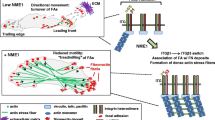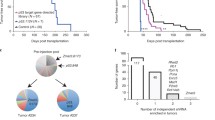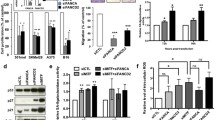Abstract
NM23-H1 is a metastasis suppressor protein that exhibits 3′-5′exonuclease activity in vitro. As 3′-5′exonucleases are generally required for maintenance of genome integrity, this activity represents a plausible candidate mediator of the metastasis suppressor properties of the NM23-H1 molecule. Consistent with an antimutator function, ablation of the yeast NM23 homolog, YNK1, results in increased mutation rates following exposure to UV irradiation and exposure to the DNA damaging agents etoposide, cisplatin, and MMS. In human cells, a DNA repair function is further suggested by increased NM23-H1 expression and nuclear translocation following DNA damage. Also, forced expression of NM23-H1 in NM23-deficient and metastatic cell lines results in coordinate downregulation of multiple DNA repair genes, possibly reflecting genomic instability associated with the NM23-deficient state. To assess the relevance of the 3′-5′exonuclease activity of NM23-H1 to its antimutator and metastasis suppressor functions, a panel of mutants harboring defects in the 3′-5′exonuclease and other enzymatic activities of the molecule (NDPK, histidine kinase) have been expressed by stable transfection in the melanoma cell line, 1205Lu. Pilot in vivo metastasis assays indicate 1205Lu cells are highly responsive to the metastasis suppressor effects of NM23-H1, thus providing a valuable model for measuring the extent to which the nuclease function opposes metastasis and metastatic progression.
Similar content being viewed by others
References
Arnaud-Dabernat S, Bourbon PM, Dierich A, Le Meur M, Daniel J-Y (2003) J Bioenerg Biomembr 35:19–30
Berberich SJ, Postel EH (1995) Oncogene 10:2343–2347
Craven RJ, Greenwell PW, Dominska M, Petes TD (2002) Genetics 161:493–507
El Deiry WS (2002) Cancer Biol Ther 1:490–491
Fan Z, Beresford PJ, Oh DY, Zhang D, Lieberman J (2003) Cell 112:659–672
Ferguson AW, Flatow U, MacDonald NJ, Larminat F, Bohr VA, Steeg PS (1996) Cancer Res 56:2931–2935
Ford JM (2005) MutatRes 577:195–202
Fukuchi T, Nikawa J, Kimura N, and Watanabe K (1993) Gene 129:141–146
Gasch AP, Huang M, Metzner S, Botstein D, Elledge SJ, Brown PO (2001) Mol Biol Cell 12:2987–3003
Gavin AC, Bosche M, Krause R, Grandi P, Marzioch M, Bauer A, Schultz J, Rick JM, Michon AM, Cruciat CM, Remor M, Hofert C, Schelder M, Brajenovic M, Ruffner H, Merino A, Klein K, Hudak M, Dickson D, Rudi T, Gnau V, Bauch A, Bastuck S, Huhse B, Leutwein C, Heurtier MA, Copley RR, Edelmann A, Querfurth E, Rybin V, Drewes G, Raida M, Bouwmeester T, Bork P, Seraphin B, Kuster B, Neubauer G, Superti-Furga G (2002) Nature 415:141–147
Glaab WE, Tindall KR (1997) Carcinogenesis 18:1–8
Grunstein M (1990) Annu Rev Cell Biol 6:643–678
Hartsough MT, Morrison DK, Salerno M, Palmieri D, Ouatas T, Mair M, Patrick J, Steeg PS (2002) J Biol Chem 277:32389–32399
Lu Q, Zhang X, Almaula N, Mathews CK, Inouye M (1995) J Mol Biol 254:337–341
Ma D, McCorkle JR, and Kaetzel DM (2004) J Biol Chem 279:18073–18084
Ma D, Xing Z, Liu B, Pedigo N, Zimmer S, Bai Z, Postel E, Kaetzel DM (2002) J Biol Chem 277:1560–1567
MacDonald NJ, De La Rosa A, Benedict MA, Freije JM, Krutsch H, Steeg PS (1993) J Biol Chem 268:25780–25789
Mankovitz R, Buchwald M, Baker RM (1974) Cell 3:221–226
Morrison AJ, Highland J, Krogan NJ, Arbel-Eden A, Greenblatt JF, Haber JE, Shen X (2004) Cell 119:767–775
Postel E, Abramczyk BM, Levit MN, Kyin S (2001) Proc Natl Acad Sci USA 97:14194–14199
Postel EH (1999) J Biol Chem 274:22821–22829
Rosen EM, Fan S, Pestell RG, Goldberg ID (2003) J Cell Physiol 196:19–41
Rossman TG, Goncharova EI, Nadas A (1995) Mutat Res 328:21–30
Shevde LA, Welch DR (2003) Cancer Lett 198:1–20
Shevelev IV, Hübscher U (2002) Nat Rev Mol Cell Biol 3:1–12
Steeg PS, Bevilacqua G, Kopper L, Thorgeirisson UP, Talmadge JE, Liotta LA, Sobel ME (1988) J Natl Cancer Inst 80:200–204
Wagner PD, Steeg PS, Vu ND (1997) Proc Natl Acad SciUSA 94:9000–9005
Author information
Authors and Affiliations
Corresponding author
Rights and permissions
About this article
Cite this article
Kaetzel, D.M., Zhang, Q., Yang, M. et al. Potential roles of 3′-5′exonuclease activity of NM23-H1 in DNA repair and malignant progression. J Bioenerg Biomembr 38, 163–167 (2006). https://doi.org/10.1007/s10863-006-9040-3
Published:
Issue Date:
DOI: https://doi.org/10.1007/s10863-006-9040-3




